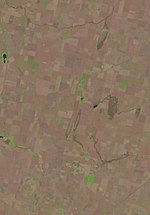A chondrite /ˈkɒndraɪt/ is a stony (non-metallic) meteorite that has not been modified, by either melting or differentiation of the parent body. They...
47 KB (5,165 words) - 17:50, 7 May 2024
Carbonaceous chondrites or C chondrites are a class of chondritic meteorites comprising at least 8 known groups and many ungrouped meteorites. They include...
30 KB (3,243 words) - 20:31, 25 April 2024
CM chondrites are a group of chondritic meteorites which resemble their type specimen, the Mighei meteorite. The CM is the most commonly recovered group...
76 KB (8,309 words) - 22:49, 25 April 2024
Enstatite chondrites (E-type chondrites) are a rare form of meteorite, rich in the mineral enstatite. Only about 200 E-Type chondrites are currently[when...
7 KB (808 words) - 11:52, 10 March 2024
chondrites. The ordinary chondrites are thought to have originated from three parent asteroids, whose fragments make up the H chondrite, L chondrite and...
4 KB (368 words) - 08:11, 24 December 2022
CI chondrites, also called C1 chondrites or Ivuna-type carbonaceous chondrites, are a group of rare carbonaceous chondrite, a type of stony meteorite...
77 KB (8,823 words) - 02:45, 6 May 2024
ordinary chondrites. The ordinary chondrites are thought to have originated from three parent asteroids, with the fragments making up the H chondrite, L chondrite...
7 KB (668 words) - 08:24, 30 May 2023
The LL chondrites are a group of stony meteorites, the least abundant group of the ordinary chondrites, accounting for about 10–11% of observed ordinary-chondrite...
4 KB (375 words) - 13:45, 14 May 2024
class H chondrite group L chondrite group LL chondrite group Enstatite chondrite class EH chondrite group EL chondrite group Other chondrite groups, not...
14 KB (1,580 words) - 03:30, 15 April 2024
The ordinary chondrites (sometimes called the O chondrites) are a class of stony chondritic meteorites. They are by far the most numerous group, comprising...
5 KB (470 words) - 20:32, 25 April 2024
Certain types of chondrites also contain small amounts of organic matter, including amino acids, and presolar grains. Chondrites are typically about...
70 KB (8,189 words) - 17:16, 20 May 2024
Asteroidal water (section Carbonaceous chondrites)
carbonaceous chondrites and enstatite chondrites in particular have higher sulfur contents than the ordinary chondrites. In C1 and C2 chondrites, sulfur is...
76 KB (8,996 words) - 02:13, 3 January 2024
Chondrites is a trace fossil ichnogenus, preserved as small branching burrows of the same diameter that superficially resemble the roots of a plant. The...
5 KB (566 words) - 16:09, 8 June 2023
Earth's deep interior. "Note: In chondrite model (1), the light element in the core is assumed to be Si. Chondrite model (2) is a model of chemical composition...
31 KB (3,015 words) - 01:34, 25 April 2024
Ordovician meteor event was a dramatic increase in the rate at which L chondrite meteorites fell to Earth during the Middle Ordovician period, about 467...
7 KB (577 words) - 19:16, 16 May 2024
that the Chicxulub impactor was a C-type asteroid with a carbonaceous chondrite-like composition, rather than a comet. In 1998, a meteorite, approximately...
82 KB (8,186 words) - 23:00, 24 April 2024
can refer to carbonaceous chondrite or to an iron meteorite designation (Roman numeral and letter). Carbonaceous chondrite CAI – an abbreviation of...
18 KB (2,091 words) - 14:42, 2 October 2023
Murchison meteorite (category Chondrite meteorites)
Australia in 1969 near Murchison, Victoria. It belongs to the carbonaceous chondrite class, a group of meteorites rich in organic compounds. Due to its mass...
20 KB (1,827 words) - 17:39, 15 April 2024
Chondrule (category Chondrite meteorites)
in a chondrite. Chondrules form as molten or partially molten droplets in space before being accreted to their parent asteroids. Because chondrites represent...
10 KB (1,121 words) - 20:30, 26 April 2024
at an opposition near perihelion. Hebe may be the parent body of the H chondrite meteorites, which account for about 40% of all meteorites striking Earth...
14 KB (1,245 words) - 06:44, 22 April 2024
Epoch, about 467.5 ± 0.28 million years ago, due to the break-up of the L chondrite parent body. It is not associated with any major extinction event. The...
72 KB (7,355 words) - 14:34, 21 May 2024
somewhere between an ordinary chondrite and a carbonaceous chondrite.[citation needed] Typical carbonaceous chondrite substance tends to be dissolved...
75 KB (8,961 words) - 13:46, 12 May 2024
Their spectra are similar to those of iron meteorites and enstatite chondrites, and radar observations have shown that their radar albedos are much higher...
26 KB (2,513 words) - 10:36, 6 January 2024
"Meteorite study suggests Earth may have been wet since it formed – Enstatite chondrite meteorites, once considered 'dry,' contain enough water to fill the oceans...
128 KB (17,507 words) - 07:18, 18 May 2024
satellites is not well understood. Their low albedo and carbonaceous chondrite composition have been regarded as similar to asteroids, supporting a capture...
209 KB (18,976 words) - 08:14, 20 May 2024
Mexico. Geochemical evidence suggests that the impactor was likely a chondrite asteroid or a comet with a chondritic component. The full extent of the...
19 KB (2,035 words) - 03:25, 15 May 2024
planets, chondrite asteroids and meteorites are common in the Solar System. Ceres and Pallas have mineral compositions similar to carbonaceous chondrites, though...
35 KB (3,361 words) - 16:40, 10 April 2024
20–24, 2001). "In-situ ion microprobe U-Pb dating of phosphates in H-chondrites" (PDF). Proceedings, Eleventh Annual V. M. Goldschmidt Conference. Hot...
45 KB (5,444 words) - 18:45, 23 February 2024
understanding of the structure. The impactor is suggested to have been a H chondrite asteroid based on ejecta layers from Italy, with the impactor thought...
11 KB (930 words) - 06:59, 11 March 2024
years Late Pleistocene or Holocene Exposed Yes Drilled No Bolide type Chondrite Location Coordinates 32°52.7′S 64°13.4′W / 32.8783°S 64.2233°W / -32...
7 KB (715 words) - 15:59, 18 September 2023
























